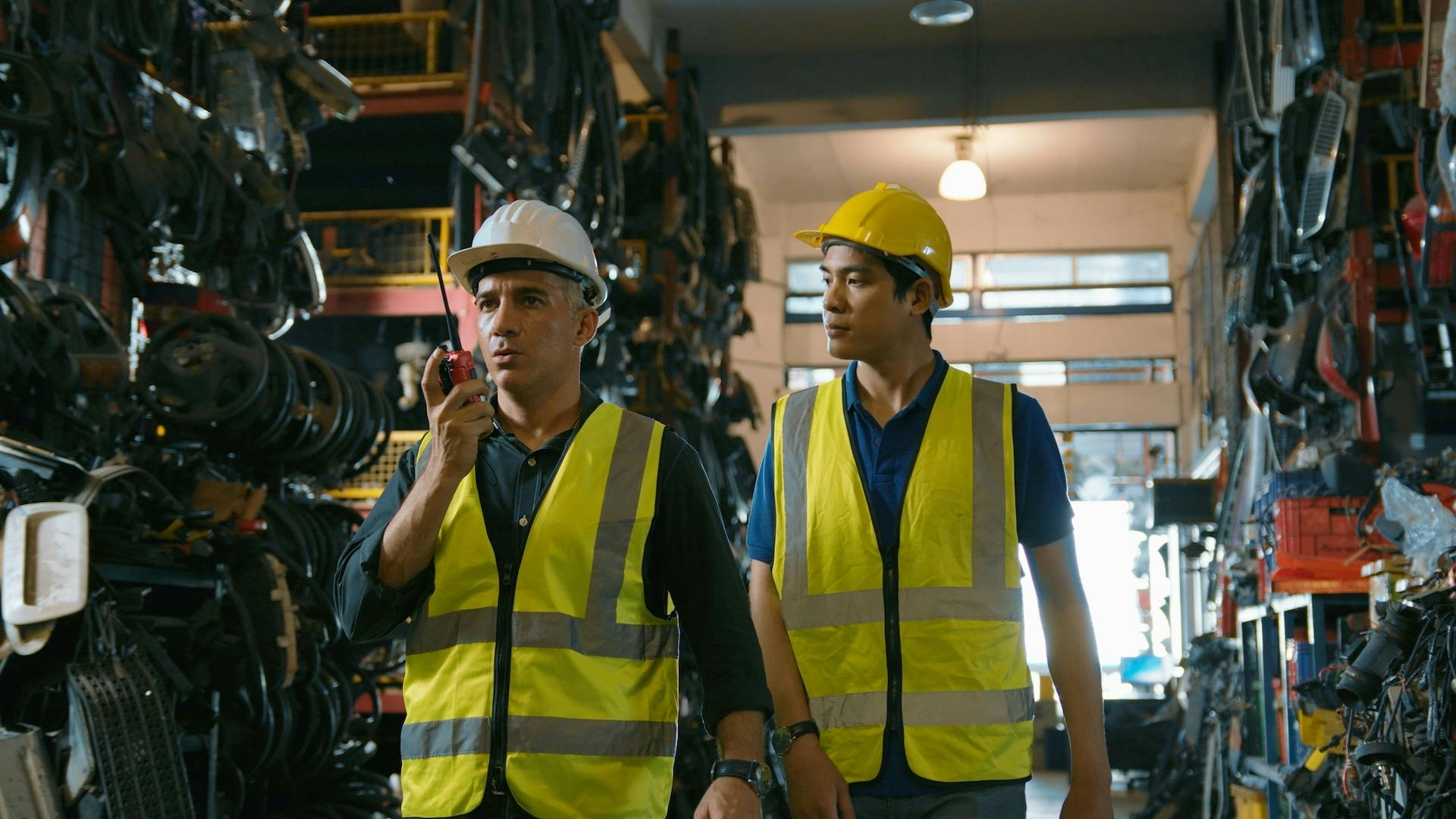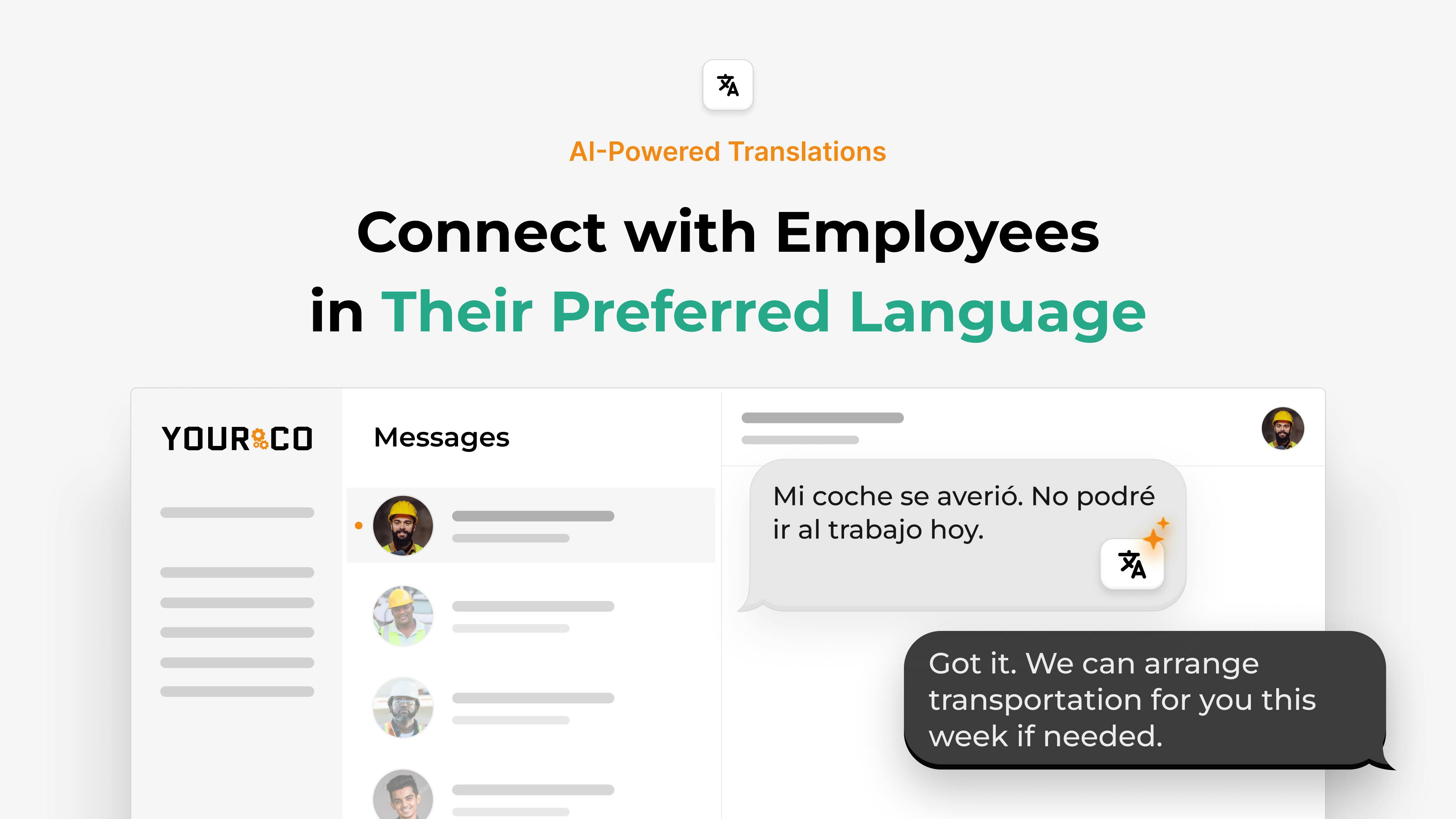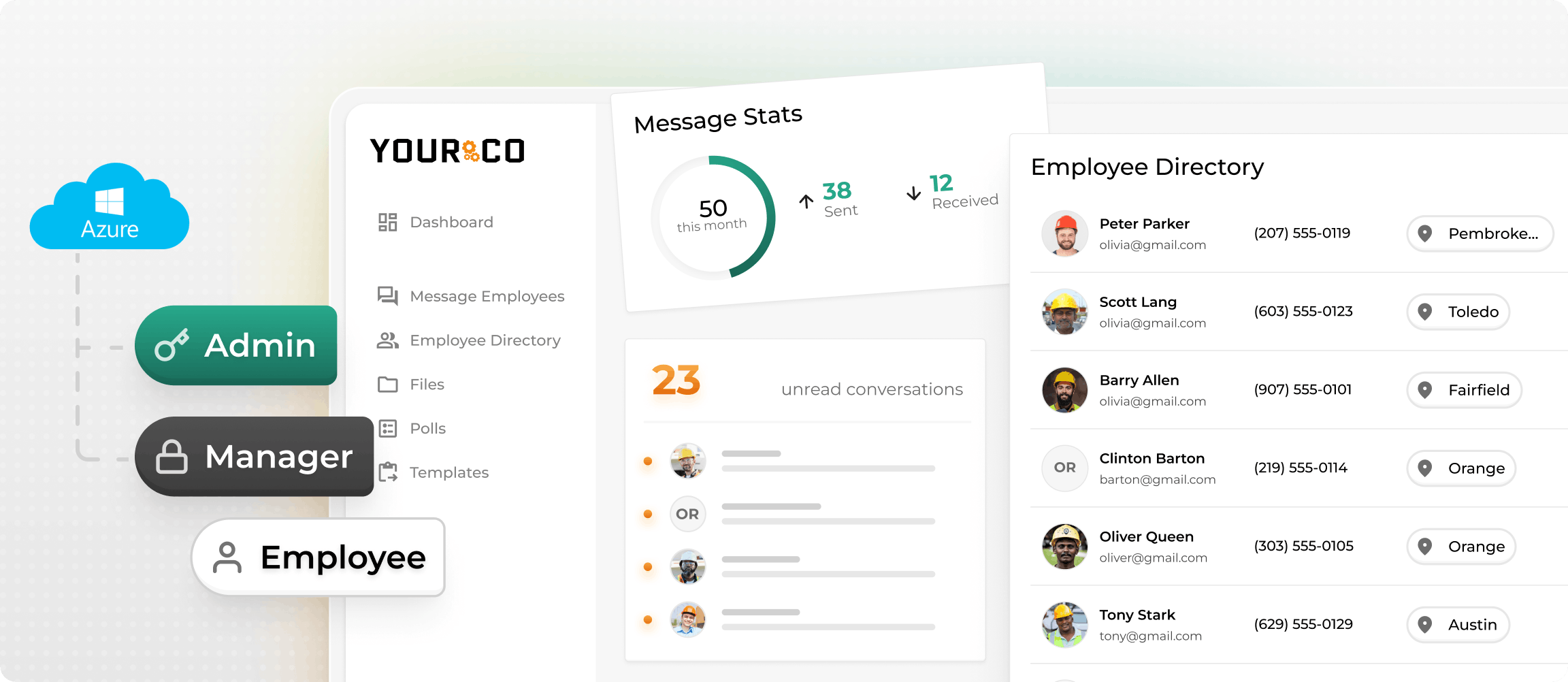Best Checklist to Onboard Spanish-Speaking Workers Successfully


Spanish is the second most common language on U.S. shop floors, construction sites, and restaurant kitchens, and the share of Spanish-speaking workers keeps climbing every hiring season. Yet many onboarding programs still hand new hires English-only forms, safety videos, and benefit guides. When the first day starts in a language someone can't fully read, you risk paperwork errors, missed safety steps, and early turnover that drains time and wages. A single mistranslated policy can even expose your company to fines or injury claims.
You can fix this problem with the right approach. Translate your key documents, ask each new hire about their language preference, and pair them with bilingual mentors. These simple steps help employees understand their role, work safely, and feel welcomed from day one. The checklist below covers every phase of integration — from the preparation stage through 90-day feedback — so you can build an inclusive program that actually works.
Before Day One: Set the Foundation
Preparation before arrival prevents confusion and compliance issues while making Spanish-speaking employees feel welcome from the start.
Prepare Translated Documents and Tools
Get key documents ready in Spanish before new hires walk through your doors. Offer letters, I-9 guides, safety procedures, and benefits information should be clear and available in their preferred language. That way you’re not scrambling to translate an emergency alert in Spanish at the last minute. This simple step reduces confusion and prevents compliance issues down the road.
Use high-quality translation methods, whether that means working with professional translators, leaning on a bilingual team member you trust, or using a platform with automated translation. Tools work well for everyday messages, policies, and quick updates. But for things like handbooks or legal documents, it's smart to have a professional take a final look to make sure everything is clear and accurate.
Checklist items:
- Translate offer letters and employment contracts
- Prepare Spanish versions of safety manuals and procedures
- Convert benefits enrollment guides to Spanish
- Create bilingual I-9 and tax form instructions
- Set up digital platforms with language switching capabilities
Ask for Language Preferences Early
Find out how each new hire wants to receive messages before they start. A quick text-based survey about spoken and written comfort levels lets them choose Spanish, English, or both. With Yourco, you can set this preference once, and every text, reminder, or survey can automatically match their language choice without manual intervention.
Knowing language preferences early helps you adjust training speed. Some employees might work through an English handbook quickly, while others benefit from Spanish video walkthroughs. Documenting these preferences shows good-faith efforts around accessibility and helps improve future translations.
Assign a Bilingual Buddy or Mentor
Pair every Spanish-speaking new hire with a trusted bilingual teammate. A quick SMS chat or phone call before the first shift lets questions come up naturally and helps new employees feel connected right away. Mentors who share language and cultural background catch confusion early and provide better safety guidance.
Choose mentors who know both the company culture and daily job realities. Give them clear expectations like weekly check-ins, quick text follow-ups, and knowing when to escalate if paperwork seems unclear.
First Day: Create Immediate Comfort
Starting the first day with Spanish-language support immediately puts new employees at ease and demonstrates your commitment to their success.
Welcome Message and Walkthrough in Spanish
Start the morning with a simple greeting in Spanish. Something like "¡Bienvenido, estamos felices de tenerte!" shows you planned specifically for their success. Give them a printed or digital agenda in Spanish so they know exactly where to go and when.
Safety training takes priority during first-day orientation. Deliver hazard briefings and facility rules in Spanish, then follow up with visual demonstrations that reinforce key points. This approach reduces accident risk and builds a strong safety culture from the first hour.
First-day priorities:
- Spanish welcome message and agenda delivered via text
- Bilingual facility tour with safety highlights
- Translated emergency procedures and exit routes shared as secure links
- Spanish-language safety demonstration
- Introduction to immediate supervisor in Spanish
Tour and Systems Overview
Walk them through the basics: time clocks, lockers, break areas, and any software they'll use daily. Set up their accounts beforehand and switch interfaces to Spanish whenever possible. When platforms only offer English, create screenshots with Spanish labels or short how-to videos.
Visual aids make a huge difference. Even experienced workers can miss key details when they're mentally translating everything. Digital platforms let you preload Spanish FAQs, which cuts down on repeated questions and gives new hires a reference they can check later.
Introduce Their Buddy and Manager
Bring in the in-person human connection. Keep introductions relaxed — grab coffee together, walk to their workstation, or chat about shared interests rather than sitting in a conference room. Give the buddy extra time on day one to answer questions privately in Spanish.
When managers join conversations, encourage real dialogue. Instead of just asking "¿Entiendes todo?" ask them to explain key points back to you in Spanish. This confirms understanding without creating pressure or embarrassment.
First Week: Build Confidence and Clarity
The first week transforms initial impressions into lasting confidence through consistent Spanish-language support and clear communication.
Conduct Bilingual Orientation
When safety briefings, HR policies, and benefits walkthroughs appear in Spanish, employees actually absorb the details instead of nodding along confused. Skip dense slide decks for photos, diagrams, or live demonstrations — visual cues work across language barriers and stick longer than text alone.
Role-specific training works the same way. Whether you're walking a forklift driver through load limits or teaching proper chemical handling, provide Spanish materials and talk through each step.
Set Clear Expectations
Translate the 30/60/90-day roadmap so new hires see milestones, mentors, and check-in dates in their own language. Keep the layout simple — icons, short bullets, and progress bars work better than long paragraphs.
Cultural considerations matter too. Some employees may hesitate to highlight their achievements, so encourage them to log wins and ask questions during each milestone conversation.
Maintain Daily Communication
Text-based check-ins in Spanish let you ask "¿Todo claro hoy?" and get instant replies from any phone, including basic models without internet access. Send a quick message every afternoon during week one, then shift to twice-weekly as confidence grows.
Modern platforms like Yourco can automatically translate your English messages into each employee's preferred language, eliminating the need to manually craft bilingual communications.
Good starter questions include:
- ''¿Entiendes los procedimientos de seguridad?''
Do you understand the safety procedures? - ''¿Necesitas ayuda con la capacitación de hoy?''
Do you need help with today's training? - ''¿Cómo te sientes con tu nuevo equipo?''
How do you feel about your new team?
Read replies for tone as well as words. Many Spanish speakers soften criticism, so phrases like "un poco confuso" (''a bit confused'') may signal a more significant issue. Follow up with a phone call or coffee chat, ideally with a bilingual buddy who can dig deeper.
First 30-90 Days: Reinforce and Recognize
The first three months determine long-term success, so focus on skills reinforcement, honest feedback collection, and celebrating progress in your employee's preferred language.
Follow Through on Training
Skills need practice beyond initial orientation, so consider texting employees secure links to refresher videos and quick reference sheets in Spanish. This approach lets them review materials anytime from their phones while building confidence through repetition. Many companies send automated text reminders for safety steps. Simple "Remember your eye protection" messages in Spanish arrive before shifts and help reduce accidents.
New hires can also text photos of completed training documents or safety checklists directly to your company number, creating instant documentation without requiring email or special apps.
Collect Regular Feedback
Send brief text-based surveys in Spanish at Day 30 and Day 90. Ask if materials were clear, which tasks still feel challenging, and how supported they feel by the team. Since text surveys achieve 98% open rates compared to just 20% for email, you'll get much better response rates and catch problems before they become safety issues or cause turnover.
Questions can be sent as simple texts that employees answer by replying with numbers (1-5 scale) or short responses, making participation easy even for those without smartphones.
Celebrate Progress and Wins
Quick public recognition, spoken in English and Spanish during daily communications, or a thank-you text after a big win, shows respect for their effort and culture. Recognition styles vary: some Spanish-speaking employees prefer team-centered praise over individual spotlights, so take cues from your buddy system when deciding how to highlight achievements.
Small gestures, such as adding a note in Spanish to the break-room board, show that bilingual communication isn't just for paperwork, but is part of everyday work life.
After 90 Days: Transition to Growth
After three months, shift focus from orientation to long-term development while maintaining language support that helped create initial success.
Create Development Pathways
Your Spanish-speaking team member should feel settled after three months. Create a simple, bilingual career roadmap that shows skills, certifications, and wages tied to each step. Provide printed or digital copies in Spanish, then schedule one-on-one conversations to walk through opportunities.
If the role eventually benefits from stronger English skills, offer optional lessons through language learning platforms. Frame language learning as a benefit, not a requirement. This approach respects current strengths while opening doors for future growth.
Continue Cultural Support
Maintain regular check-ins with the original bilingual buddy. This helps employees navigate unwritten rules and workplace norms that don't appear in training manuals. Mentoring programs that value language and culture drive engagement over time.
Encourage new employees to text questions or concerns directly to their supervisor's company number. They can even send photos of equipment issues or safety concerns for immediate documentation and response.
Request Process Feedback
Strong programs keep improving. Send a short Day-90 survey in Spanish that covers training clarity, sense of belonging, and role confidence. Design questions that stay open-ended and culturally aware.
Look beyond satisfaction scores when responses arrive. Track early warning signs like repeated safety questions or slow benefits enrollment. Connect survey insights with retention, attendance, and incident data to spot patterns and adjust future processes.
Close the loop by sharing key findings and action steps with both the employee and their manager. Showing that feedback leads to change proves input matters and sets the tone for ongoing support.
Build Stronger Teams with Smart Communication
Language-inclusive onboarding transforms how Spanish-speaking employees experience their first months at your company. When you provide translated materials, assign bilingual mentors, and maintain clear communication throughout the integration process, you create an environment where everyone can succeed from day one.
The difference comes down to meeting people where they are. Instead of expecting employees to navigate complex safety procedures or benefits enrollment in their second language, you remove barriers and show respect for the skills and experience they bring to your team.
Yourco makes this approach sustainable across multiple locations and hiring cycles. Learn more about how to onboard Spanish-speaking employees effectively while maintaining compliance and safety standards. New hires can text photos of their documentation — no email or physical delivery needed. You can send welcome messages, training materials, and 30/60/90-day follow-ups in their preferred language, while they can ask questions about procedures or forms at their convenience via text.
With AI-powered translation that automatically converts messages to over 135 languages and dialects, and instant delivery that works on any phone, you can maintain personal connections while scaling efficiently across your entire organization.
Ready to transform your onboarding system? Try Yourco for free today or schedule a demo to experience a more effective, inclusive process.
Frequently Asked Questions
What's the quickest way to learn a new hire's language preference?
Ask during the application or offer stage. A simple question lets employees choose Spanish, English, or both. Modern communication platforms can store that choice so every text message, survey, and reminder automatically goes out in the right language without extra work for HR teams.
Are automated translation tools sufficient for onboarding materials?
For quick daily messages, automated tools work well. However, contracts, safety manuals, and policy documents need professional translators to avoid costly mistakes. Expert translators help protect you from misunderstandings and compliance issues that machine translation might create.
How can I confirm Spanish-speaking employees understand safety procedures?
Pair clear Spanish instructions with hands-on practice and visuals. Follow up during their first week and again at 30 days. Text reminders work well here—send quick refreshers and ask employees to reply "OK" once they've reviewed a step. This approach supports workplace safety guidelines while creating documentation.
How do I maintain engagement after the first week?
Keep sending updates, shift changes, and surveys in Spanish. Two-way texting keeps communication open even when employees work off-site. Platforms with automatic language switching make it simple to check in regularly and show new hires you're still paying attention after orientation ends.




